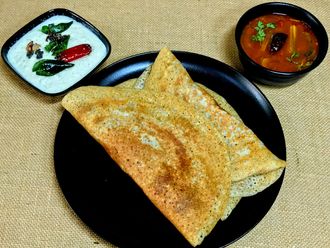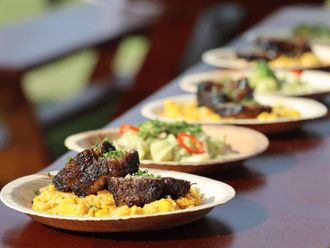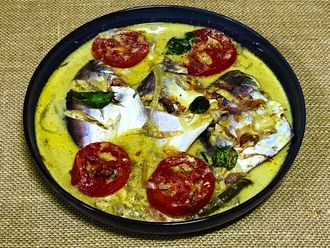Preparation time: 2 hours
Cooking time: 45 to 60 minutes
Servings: 15 to 18
Ingredients
For pastry
250 gms All-purpose flour
½ tsp Baking powder
½ tsp Salt
140 ml Whole milk at room temperature
1½ tbsp Oil
For filling
100 gms Red onion, chopped
50 gms Spring onion, chopped
50 gms Green chilli, chopped
10 gms Garlic
½ cup Parsley
½ Habanero, de-seeded
2 tbsp Oil
2 tsp Fish sauce
170 gms Canned tuna
3 cups Oil for frying
Senegalese Sosu Kaani (Pepper sauce)
200 gms Tomatoes, chopped
100 gms Red onion, chopped
1 Green chilli, chopped
2 Garlic cloves, chopped
1 Habanero
1 Bay leaf
¼ cup Oil
1 tbsp Tomato paste
½ tsp Salt
2 tsp Fish sauce
¼ tsp Black pepper to taste
2 Limes, juiced
Ketchup (store-bought)
Method
Sift the flour, baking powder and salt into a large bowl and add the milk and oil.
Use a fork to combine lightly, then transfer to the clean kitchen countertop and knead all the ingredients together until a smooth, non-stick ball is formed.
Place the pastry dough in the bowl and cover with cling film. Let it rest for 45 minutes to an hour.
In the meantime, prepare the filling for the fataya. Chop the red onion, spring onion, long green chilli pepper, garlic, parsley, and Habanero (if using) into large pieces.
Add them to a food processor and blend for 1 to 2 minutes in 30-second intervals until chopped into small bits.
Place a small frying pan over a medium-low flame and heat the oil for 2 to 3 minutes. Add the ingredients from the food processor to the pan and stir fry for 5 to 7 minutes until fragrant and cooked. Stir in the fish sauce and remove from the heat to cool for 10 minutes.
Drain the canned tuna and add it to the food processor, along with the cooked aromatics. Blend for 2 to 3 minutes to combine the aromatics with the tuna, and the filling will turn into a paste-like consistency.
Transfer the filling to a bowl and set aside.
Clean the kitchen countertop and lightly dust it with flour.
Cut the pastry in half (I prefer to work in batches as it is easier to roll the pastry this way, but you can roll it out all at once), and wrap the other half with cling film to prevent it from drying out.
Using a rolling pin, roll out the dough to 0.25cm thickness. Using a pastry cutter or bowl of approximately 9.5 cm to 10 cm diameter, cut out circles of this size from the rolled-out dough. Wrap the left-over dough from the cut-out with the second portion in the cling film, for the second rolling round.
Fill a small bowl with some water and keep aside. Take one pastry circle, measure one teaspoon of the filling and place it in the middle. Dab the edges of the pastry circle with some water, then with the filling in the middle, turn to seal the filling in.
Using a fork, press all the edges of the fataya to ensure the filling is not spilling out.
Line a large oven tray or two medium oven trays with baking paper.
Place the filled pastry in them and repeat with the rest of the pastry circles and dough until the filling and dough are finished. Pastry circles of this size (9.5cm – 10cm diameter) should produce 15 to 18 servings.
Place this in the freezer and prepare the sosu kaani.
Chop the tomatoes, red onion, long green chilli pepper, garlic, and Habanero (if using) and put them into a blender. Add ¼ cups of water to help the blades blend, and blend for 1 minute until smooth.
Heat the oil in a small saucepan over a medium flame. Once hot, add the blended ingredients to the oil with the bay leaf and stir. Cook for approximately 15 minutes until reduced, and most water evaporates, stirring continuously to prevent burning.
Add the tomato paste and cook for five more minutes. Add the salt, fish sauce, black pepper, and lime juice. Cook for one minute more, then remove from the heat. Set aside to cool.
Add the 3 cups of oil to a medium saucepan and place over a medium flame. Heat the oil for about 5 minutes to approximately 170°C.
Remove the fatayas from the freezer and fry in batches of 5 to 6 for approximately 5 minutes until golden brown on both sides, ensuring you do not overcrowd the pan.
Line a plate with paper towels to drain excess oil from the fried fatayas.
Serve hot with ketchup and sosu kaani.
Tips
Habanero can be substituted with red bird's eye chilli, which is optional.
Make sure to seal the dough after filling it by pressing it near the edge with a fork.

These delectable snacks from Senegal are a beloved and widely popular street food that holds a special place. During Ramadan, these savoury treats are a staple on the bustling streets, delighting locals and visitors alike with their irresistible aroma and flavourful goodness.
Do you have a favourite recipe to share? Write to us at food@gulfnews.com.


















